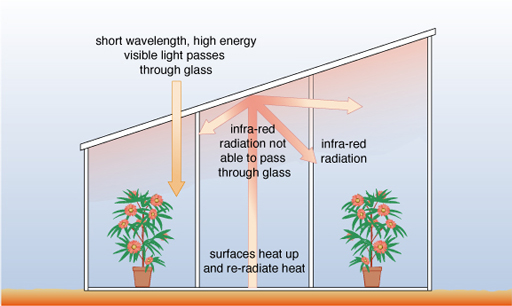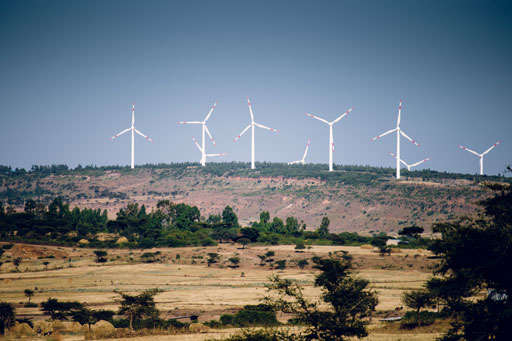15.6 Climate change
The effects of climate change are already being experienced in Ethiopia (EPA, n.d.). Climate change is the long-term variation in global climate largely attributed to human activities, especially the production of greenhouse gases (e.g. carbon dioxide, methane). These are gases that, when released to the atmosphere, trap the heat from the sun and cause warming of the global climate. Figure 15.5 shows how this process operates.

In recent decades, Ethiopia has become warmer and rainfall has become more variable. Table 15.2 shows this historical trend and how the climate models have predicted the possible future changes. As you can see, as well as changes to temperature and rainfall, there are also expectations of increased uncertainty about extreme events of flood and drought. The weather in Ethiopia is likely to become more unpredictable and this will impact on many sectors, including health, agriculture and natural resources, including water.
| Temperature | Rainfall | Extreme events | |
|---|---|---|---|
| Historical trend | Mean temperature increased by 1.3°C from 1960 to 2006. More hot days and nights, fewer cold days and nights | Highly variable from year to year, season to season, decade to decade. No significant trend | Regular, severe floods and drought events. No evidence of changes in frequency or intensity of extremes |
| 2020s | +1.2°C (range 0.7–2.3°C) | +0.4% increase in rainfall | Greater increases in rainfall from October to December, especially in the south and east |
| 2050s | +2.2°C (range 1.4–2.9°C) | +1.1% increase in rainfall | Heavier rainfall events, uncertain future El Niño behaviour brings large uncertainties |
| 2090s | +3.3°C (range 1.5–5.1°C) | Wetter conditions | Flood and drought events likely to increase, heatwaves and higher evaporation |
The future uncertainties of climate change are acknowledged in the OWNP document and it recognises that water supplies are vulnerable to climate variability. Some existing water sources may dry out during prolonged dry periods, but it is also possible that increased rainfall will improve supply. Future plans need to incorporate how they will adapt to these possible changes. Adaptation to climate change means modifying actions and behaviours to cope with the changed situation, for example, using scarce water resources more efficiently would be one way of adapting to reduced water supplies. The greatest problem with climate change is the level of uncertainty about the future which makes it very difficult to prepare strategic plans for the longer term.
In response to these challenges, the Ethiopian government has mandated the Environmental Protection Authority (EPA) to coordinate the national response to climate change and to develop national plans for a climate-resilient economy. Climate resilience is the ability to cope with and manage a changing and uncertain climate. A climate-resilient economy is an economy designed to withstand the possible negative impacts of extreme weather events and long-term climate trends, so that the well-being of the people and the national economy are not damaged (EPA, n.d.).
In 2014, Ethiopia’s Programme of Adaptation to Climate Change (EPACC) was launched. This is a programme of action to build a climate-resilient economy involving all levels, from sectoral and regional to local communities. It aims to involve the whole population in planning and implementing adaptation to climate change and includes the objective to ‘manage water effectively to make it always available to humans, animals and crops’ (EPA, n.d.).
Ethiopia is not responsible for the historic atmospheric greenhouse gas emissions, but nevertheless it has developed plans for actions to mitigate climate change. These are called the Nationally Appropriate Mitigation Actions (NAMAs). They cover seven areas of activity, all designed to decrease the production of greenhouse gases in Ethiopia. One of the most important is electricity generation by renewable energy such as hydropower, wind power and geothermal power, both at national grid and local level and on a domestic scale. Figure 15.6 shows an example of a renewable energy scheme.

What is the difference between adaptation to climate change and mitigation of climate change?
If you adapt to something you make changes that allow you to cope with the change, so adaptation to climate change means changing programmes, activities, behaviours etc. in response to a changing situation. Mitigation means reducing the negative effects of something, so in this instance it would mean trying to prevent further climate change from happening.
15.5 Industrialisation
